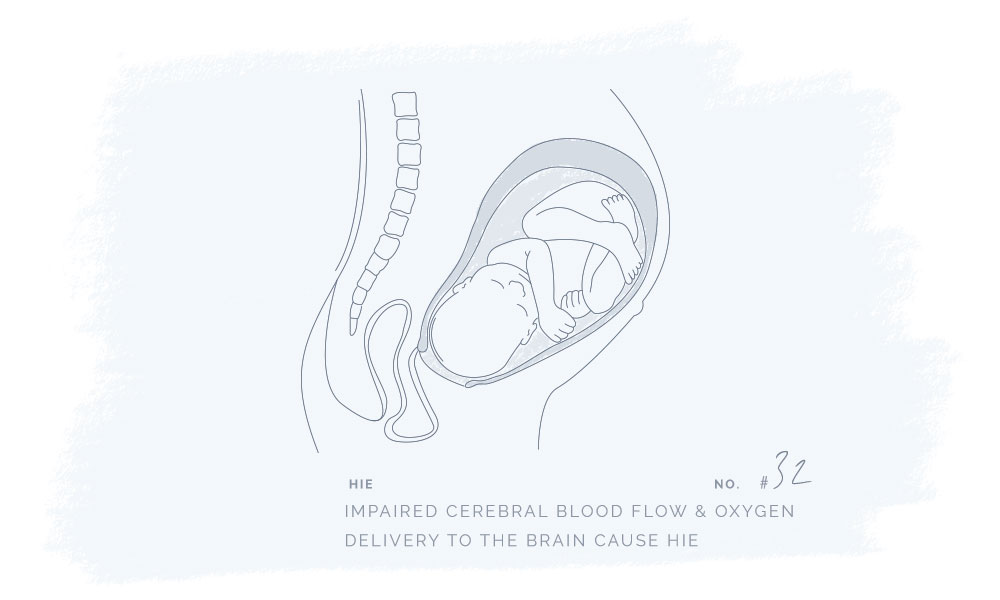Hypoxic-ischemic encephalopathy
Category
Birth complications
REVIEWED BY
Our Biomedical Scientist
Reviewed based on
Literature Discussion
Last update
October 2020

What is HIE
Hypoxic-ischemic encephalopathy (HIE) is a medical emergency and serious birth complication caused by impaired cerebral blood flow and oxygen delivery to the brain.
The complication may be fatal in newborns and/or cause severe disabilities such as developmental delay, cognitive impairments, or cerebral palsy.1
The connection between Cannabinoids & HIE
Studies find that CBD and THC may have great therapeutic potential and may be used to help treat HIE. CBD and THC are well-known cannabinoids, however, they do not have the same psychoactive effects. THC is psychoactive while CBD does not possess psychoactive effects. According to WHO guidelines, the cannabidiol CBD is generally well tolerated with a good safety profile.
The endocannabinoid system may be involved in controlling the underlying processes of HIE when it is happening. Therefore, cannabinoids may help improve the symptoms associated with it. Preclinical data proposes that the cannabinoid CBD may be a viable therapeutic in the treatment of HIE.2
The literature discussion is an overview of the published results from scientific studies investigating if and how cannabinoids can be beneficial in the treatment of Psoriasis. The overview will be updated regularly to ensure the newest and most accurate information.
Cannabinoid receptors and endocannabinoids may be involved in HIE
The endocannabinoid system is involved in neonatal Hypoxic-ischemic encephalopathy. It was shown that CB1 and CB2 are increased and anandamide, 2AG, OEA, and PEA demonstrate elevated levels after cerebral ischemia.3,4
Astrocytic reaction, neuronal death, and dendritic loss can be reduced through selective activation of CB1 in a stoke model in adult mice. 5
Neuroinflammation, ischemic injury, and cognitive deficits can be reduced through selective activation of CB2 in different models of stroke.6,7,8
In hypoxia-ischemic animal models, CBD has been demonstrated to have neuroprotective properties with functional and behavioral recovery.9,10
Clinical trials are research studies that examine new treatments and evaluate their effects on human health outcomes.
Today, we are not able to provide any clinical trials about cannabinoids and HIE.
- Allen, K., Brandon, D., (2011). ”Hypoxic Ischemic Encephalopathy: Pathophysiology and Experimental Treatments”. https://www.ncbi.nlm.nih.gov/pmc/articles/PMC3171747/
- https://ghmedical.com/endocannabinoid-system/diseases/hypoxic-ischemic-encephalopathy
- England, T.J., Et al., (2015). ”Cannabinoids in experimental stroke: a systematic review and meta-analysis. J. Cereb. Blood Flow Metab. Off. J. Int. Soc. Cereb. Blood Flow Metab. 35, 348–358”. https://pubmed.ncbi.nlm.nih.gov/25492113/
- Lara-Celador, I., Et al., 2013). “Using the endocannabinoid system as a neuroprotective strategy in perinatal hypoxic-ischemic brain injury. Neural Regen. 8, 731–744”. https://www.ncbi.nlm.nih.gov/pmc/articles/PMC4146074/
- Caltana, L., Et al., 2015). “Cannabinoid receptor type 1 agonist ACEA improves motor recovery and protects neurons in ischemic stroke in mice. J. Neurochem. 135, 616–629”. https://pubmed.ncbi.nlm.nih.gov/26296704/
- Choi, Y.I.,Et al., (2013). ”Activation of cannabinoid CB2 receptor-mediated AMPK/CREB pathway reduces cerebral ischemic injury. J. Pathol. 182, 928–939”. https://pubmed.ncbi.nlm.nih.gov/23414569/
- Ronca,R.D., Et al., (2015). ”A selective cannabinoid CB2 agonist attenuates damage and improves memory retention following stroke in mice. Life Sci. 138, 72–77”. https://pubmed.ncbi.nlm.nih.gov/26032254/
- Zarruk, J.G., et al., (2012). “Cannabinoid type 2 receptor activation downregulates stroke-induced classic and alternative brain macrophage/microglial activation concomitant to neuroprotection. stroke J. Cereb. 43, 211–219”. https://pubmed.ncbi.nlm.nih.gov/22020035/
- Alvarez, F.J., Et al., (2008). ”Neuroprotective effects of the nonpsychoactive cannabinoid cannabidiol in hypoxic-ischemic newborn piglets. Res. 64, 653–658”. https://www.nature.com/articles/pr2008260
- Lafuente, H., Et al., (2011). ”Cannabidiol Reduces Brain Damage and Improves Functional Recovery After Acute Hypoxia-Ischemia in Newborn Pigs. Res. 70, 272–277”. https://pubmed.ncbi.nlm.nih.gov/21654550/
CANNABINOIDS & RECEPTORS
Below you find the plant cannabinoids, cannabinoid receptors, and endocannabinoids that are associated with the potential therapy.
- CB1
- CB2
- GPR55,
- PPARγ,
- A2A
- 5-HT1A
- Anandamide
- OEA
- 2AG
- PEA
If you have any further information relevant to the connection between HIE and cannabinoids or find any of the information inaccurate, outdated or incomplete please contact us here.

